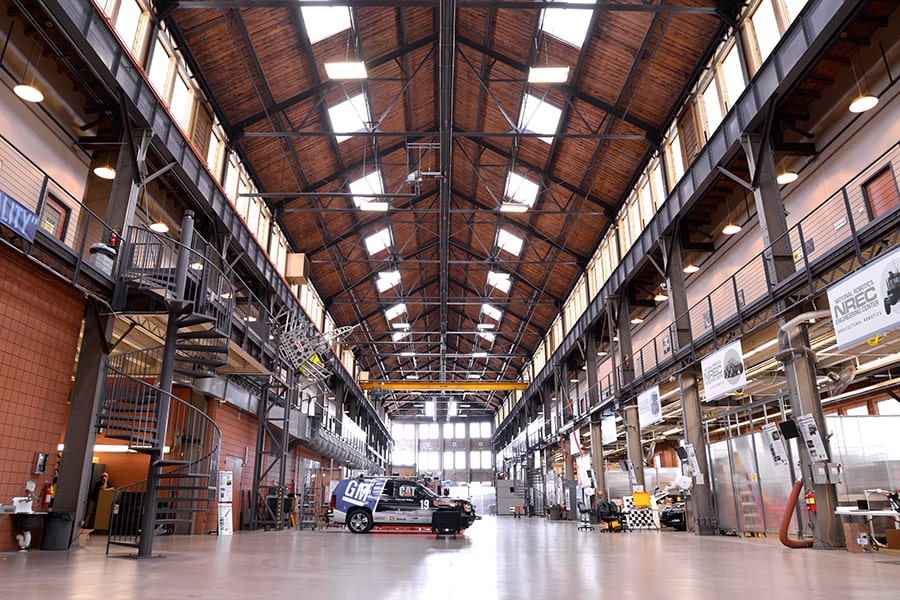Pittsburgh Robotics Network hosted a panel focused on off-road autonomy and field robotics at Lawrenceville’s Caterpillar Pittsburgh Automation Center last week in an attempt to imagine what that future of the industry could look like, and examine its past.
Caterpillar Chief Engineer Anthony McNealy moderated a discussion with local leaders: Oshkosh Corporation Director of Autonomy & Active Safety John Beck, Carnegie Robotics President and CEO John Bares, Neya Systems Director of Robotics Andrew Capodieci, and Advanced Construction Robotics CEO Danielle Proctor.
What are the challenges and opportunities currently facing the industry? Panelists said managing the public’s expectations will be important as the tech is developed and released, while Pittsburgh’s decades of expertise are a boon for its future.
Managing the public’s expectations
In the world of robotics, connections aren’t limited to machines, Pittsburgh Robotics Network Executive Director Joel Reed told the crowd — robotics companies in the regions must make strategic connections to each other, too. Not only that, Reed said, but it’s important to keep residents informed about the solutions they’re developing for the future.
“People want to know what was happening in Pittsburgh,” Reed said. “So that’s really what we [PRN] do, we get the word out, we tell your stories, we make these strategic connections.”
That speaks to one of the bigger challenges facing the off-road autonomy and field robotics industries now, according to Advanced Construction Robotics’ Proctor: the high expectations that people have for bots’ capabilities and performances. Not everyone trusts autonomous technology yet, so there’s likely to be less forgiveness for a robot that makes a mistake as opposed to a person, Proctor said. Thus, roboticists must manage their machines’ potential faults and the public’s expectations carefully: “We have to communicate to our users that our robots may be stupid.”
Another cause of difficulty can be pricing. All the panelists agreed that making robots is a time consuming and expensive enterprise. One method of save money in the long run, Carnegie Robotics’ Bares said, is to work closely with the customer.
“Working closely with customers to manage expectations and understand the strengths and limitations to a production reduces the costs significantly,” he said.
The technology itself is taking on difficult challenges, depending on what you want your robot to do. If, like Neya Systems’ Capodieci, your company is developing autonomous solutions to navigate unknown terrain for military or mining missions, then infrastructure could be a problem. In the absence of pavement, robots might not be able to determine the drivability of an area.
“You really need to consider the dynamic obstacles specifically around [a] track — dynamic actors, cars, trucks, pedestrians, bicyclists,” Capodieci said.
The industry must also contend with the fear some laborers have that the use of robots will mean unemployment for them. When House Bill 2398, which lifted the human driver requirement for AV testing, was making its way through the Pennsylvania Senate in November 2022, some labor unions were concerned that self-driving cars and trucks would take jobs away from drivers. (The bill later became law.) At the time, the bill’s supporters argued that companies were already struggling to fill driving positions. Proctor argued that autonomous technology would actually create jobs.
“We are a modern approach to an age-old problem,” the CEO said. “People [will] understand that we’re not here to replace, necessarily, but we’re here to help augment, whether it’s productivity or efficiency.”
A culture toward collaboration and problem solving
Something panelists feel works in their favor is the culture of the industry. From the research to the actual building, Bares said, most roboticists are very passionate about what they’re doing. This leads to a positive environment where the long-term vision of the company can be achieved and good work can be done. And having been in the field for a long time himself, he said it helps that many roboticists in the industry have dedicated years to honing their area of expertise.
Proctor also finds it encouraging that robotics is moving into a more “open” industry: It’s no longer just engineers working in seclusion, but a system of people who are needed to accomplish the end goal.
“You can’t just sit in a bubble, you have to start talking and learning from your fellow team members,” Proctor said. “And if you can build that level of trust [and] calm, all those discussions will be easier to hash things out and work more efficiently.”
One of the reasons that Pittsburgh has been able to rise as a prominent location in the robotics community is because the city’s roboticists remain willing to take risks, panelists said. Bares noted that from Carnegie Mellon University’s work with students in the 1980s to creating the Robotics Institute, plenty of effort had been invested into the industry even before robotics companies setting up shop in the Strip District was the norm.
“Carnegie Mellon University was full of growing people in terms of students, but also growing researchers taking risks, financial risks, legal risks, everything else,” Bares said. “And I think that’s at the heart a lot of the growth we have now.”
As a whole, despite production hiccups within the industry or the public’s misconceptions to contend with, all the panelists agreed that the city remains on track to hold an important place in the future of the robotics industry.
“We made a bold claim about two years ago that we are the robotics capital of the world and we really are creating a center of influence right here in Pittsburgh,” Reed said.







